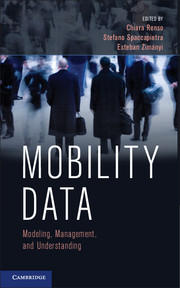Book contents
- Frontmatter
- Contents
- List of Contributors
- Preface
- Acknowledgments
- PART I MOBILITY DATA MODELING AND REPRESENTATION
- 1 Trajectories and Their Representations
- 2 Trajectory Collection and Reconstruction
- 3 Trajectory Databases
- 4 Trajectory Data Warehouses
- 5 Mobility and Uncertainty
- PART II MOBILITY DATA UNDERSTANDING
- PART III MOBILITY APPLICATIONS
- PART IV FUTURE CHALLENGES AND CONCLUSIONS
- Bibliography
- Glossary
- Author Index
- Subject Index
- Plate section
3 - Trajectory Databases
from PART I - MOBILITY DATA MODELING AND REPRESENTATION
Published online by Cambridge University Press: 05 October 2013
- Frontmatter
- Contents
- List of Contributors
- Preface
- Acknowledgments
- PART I MOBILITY DATA MODELING AND REPRESENTATION
- 1 Trajectories and Their Representations
- 2 Trajectory Collection and Reconstruction
- 3 Trajectory Databases
- 4 Trajectory Data Warehouses
- 5 Mobility and Uncertainty
- PART II MOBILITY DATA UNDERSTANDING
- PART III MOBILITY APPLICATIONS
- PART IV FUTURE CHALLENGES AND CONCLUSIONS
- Bibliography
- Glossary
- Author Index
- Subject Index
- Plate section
Summary
Introduction
In this chapter, we consider the problem of modeling and representing trajectories in the context of database systems. Since about 1995 there has been research on moving objects databases (MODs), also termed spatio-temporal databases. The general goal has been to allow one to represent moving entities in databases and to enable a user to ask all kinds of questions about such movements. This requires extensions of the DBMS data model and query language. Further, DBMS implementation needs to be extended at all levels, for example, by providing data structures for representation of moving objects, efficient algorithms for query operations, indexing and join techniques, extensions of the query optimizer, and extensions of the user interface to visualize and animate moving objects.
Moving objects databases come in two types. The first represents a set of currently moving objects. One is interested in maintaining the current locations and asking queries about current and expected near future locations. The second type maintains complete histories of movement. These are sometimes called trajectory databases and are the topic of this chapter.
Whereas spatio-temporal databases had been around for a much longer time, they supported only discrete changes of geometries over time. The emphasis in the new field of moving objects databases is to consider continuously changing geometries. Neither the position of a car on a road nor the shape and location of a hurricane changes in discrete steps; these are clearly continuous phenomena.
- Type
- Chapter
- Information
- Mobility DataModeling, Management, and Understanding, pp. 42 - 61Publisher: Cambridge University PressPrint publication year: 2013
- 5
- Cited by



